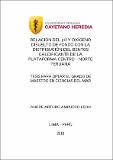Por favor, use este identificador para citar o enlazar este ítem:
https://hdl.handle.net/20.500.12958/3188| Título : | Relación de pH y oxígeno disuelto de fondo con la distribución de bentos calcificante de la plataforma centro - norte peruana |
| Autor : | Ampuero León, Andre Arturo |
| Director : | Gutierres Aguilar, Dimitri |
| Palabras clave : | Macrobentos;Costa Peruana;Oxígeno disuelto;Afloramiento |
| Fecha de publicación : | 2018 |
| Editorial : | Universidad Peruana Cayetano Heredia |
| Resumen : | El presente estudio busca conocer la influencia combinada de la deficiencia de
oxígeno y bajo pH sobre los parámetros comunitarios y la composición del
macrobentos calcificante, además de analizar su estructura espacial, entre los
años 2007 al 2014 en la plataforma centro norte peruana (3°-9°S). También se
evaluaron los cambios decenales del macrobentos calcificante ante el oxígeno
disuelto de fondo entre los años 1976 al 2015. Para el pH de fondo se utilizaron
datos simulados, validados y corregidos, del modelo ROMS-PISCES a una
resolución espacial de 1/9°. La información fue clasificada en escenarios de
alto/bajo oxígeno y alto/bajo pH en cuatro categorías combinadas, evaluándose
los parámetros comunitarios del macrobentos calcificante como variables
dependientes. Las mayores abundancias del macrobentos calcificante se
registraron hacia el sur de los 6°S, donde existe mayor enriquecimiento orgánico
y deficiencia de oxígeno. La riqueza específica presentó los menores valores
bajo escenarios de pH y oxígeno bajos. Asimismo, los índices de diversidad
fueron mayores cuando el oxígeno fue elevado y el pH bajo. El bivalvo Solemya
sp. fue la única especie tolerante tanto a condiciones hipóxicas como de bajo pH.
Por último, el aumento de abundancias de crustáceos hacia el período 1995 –
2009 correspondió con la oxigenación de fondo registrada en dicho período. Se
hace necesaria una revisión de la diversidad y adaptaciones del macrobentos
calcificante asociado a zonas de afloramiento. ABSTRACT: The present study aims to examine the combined influence of oxygen deficiency and low pH conditions on the community parameters and the composition of the calcifying macrobenthos, besides analyzing its spatial structure, between 2007 and 2014 in the north central Peruvian shelf (3 ° -9 ° S). The decadal changes of the calcifying macrobenthos were also evaluated against the bottom dissolved oxygen content between 1976 and 2015. For the bottom pH, simulated data from the ROMS-PISCES model, which was previously validated and corrected, were used at a spatial resolution of 1/9°. The oxygen and pH conditions were classified into four combined categories, evaluating the community parameters of the calcifying macrobenthos as dependent variables. The highest abundances of calcifying macrobenthos were recorded south of 6°S, where there is a greater organic enrichment and oxygen deficiency. Species richness of the calcifying macrobenthos showed the lowest values at both low pH and oxygen conditions. Also, diversity indexes were the highest when oxygen was high and pH low. The bivalve Solemya sp. was the only species that tolerated both hypoxic and low pH conditions. Finally, bottom oxygenation towards the period 1995 – 2009 corresponds to the increase of crustacean abundance. It is necessary to review the calcifying macrobenthos diversity and adaptations associated with upwelling areas. |
| Descripción : | Tesis (Maestro Ciencia del Mar).- Universidad Peruana Cayetano Heredia |
| URI : | https://hdl.handle.net/20.500.12958/3188 |
| Aparece en las colecciones: | Tesis de Postgrado |
Ficheros en este ítem:
| Fichero | Descripción | Tamaño | Formato | |
|---|---|---|---|---|
| Ampuero Leon.pdf | 8,41 MB | Adobe PDF |  Visualizar/Abrir |
Este ítem está sujeto a una licencia Creative Commons Licencia Creative Commons

